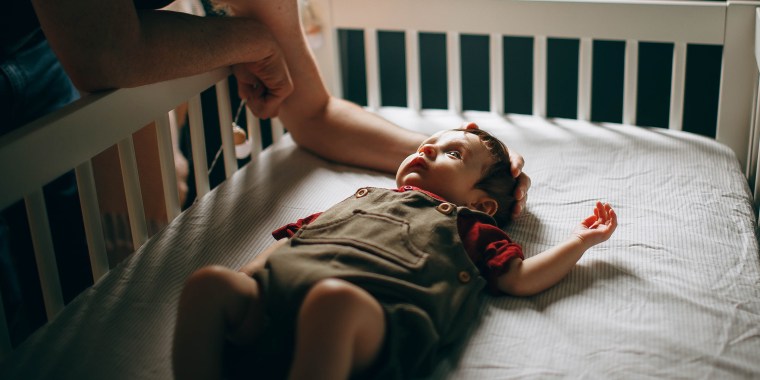If you’re looking forward to outfitting your newborn’s crib, remember three words — less is best. According to the American Academy of Pediatrics (AAP), all you need in the baby’s crib is a firm, flat mattress and a snug fitted sheet — oh, and baby, of course. You won’t need that adorable bumper pad and cozy matching blanket — or that cuddly teddy bear, either. In fact, those items could be a hazard to your baby’s safety.
Why baby crib bumper pads are not safe
Bumper pads are of little use in keeping a baby safe, according to the AAP. They may appear to be a great way to protect your baby, but crib bumpers increase an infant’s risk of accidental suffocation and entrapment. Additionally, since June 2011, government regulations of crib safety standards have limited the opening between crib slats to 2 3/8 inches, making cribs safer for babies.
“That’s the width of a soda can,” Michael Goodstein, MD, neonatologist at WellSpan Health in York, Pennsylvania, and the director of Cribs for Kids in York County, told TODAY Parents. “A baby’s body (or head) cannot slip through that opening. Parents worry about limbs getting trapped in between slats, but that’s not a life-threatening injury. A baby could die, however, if he got his face caught against a bumper or his head tangled in a bumper pad.”
If you’re concerned about your baby’s legs slipping through the crib slats, Dr. Goodstein suggested dressing your baby in a sleep-sack or lightweight wearable blanket to keep the legs safely enclosed.
The Consumer Product Safety Commission (CPSC) also supports the no-bumpers position. In a 2017 report, the organization analyzed 107 fatal and 282 nonfatal incidents associated with crib bumpers between January 1990 and March 2016. The analysis suggested that bumper pads in cribs caused deaths and near-deadly injuries when:
- The baby’s head became entrapped between the bumper pad and the mattress, causing suffocation.
- Infants choked after a loose bumper pad became wrapped around their neck.
- Infants suffocated or nearly suffocated when their face pressed against the bumper pad. (This caused re-breathing, a scenario in which the baby inhales their own exhaled air.)
Are breathable crib bumpers safe?
“There are breathe-through bumpers on the market, but they are not approved by the AAP,” Carolynne Harvey, a baby sleep consultant for 4moms and founder of Dream Baby Sleep, told TODAY Parents. “In fact, there is no such thing as a safe, breathe-through bumper.”
You may be wondering about mesh crib liner safety, but even bumpers that are made of mesh can be unsafe in cribs. If mesh bumpers come loose, they could strangle the baby or trap him between the bumper and the mattress. The same is true for vertical crib liners, which enclose crib slats. These don't contribute to crib rail cover safety, rather they can make the crib less safe, since babies can become wedged between them and the crib mattress. Additionally, if the liners come loose, they could be a strangulation risk.
Giving bumpers the bump
As a result of the Safe Cribs Act, which passed the House in 2021 and is awaiting action in the Senate, padded bumper pads for cribs will be banned in 2022. Unfortunately, parents may come across them at garage sales, secondhand stores and even passed down from friends. No matter where you see them, remember that the AAP does not approve the use of bumper pads for baby cribs. It doesn’t get any simpler than that.
Crib clutter to avoid
Other items that are unsafe to use in the cribs of babies under one year old include:
- Blankets
- Comforters
- Top sheets
- Pillows
- Stuffed toys and other soft objects
Products like these can obstruct a baby’s breathing, cause a baby to overheat, trap an infant, and block their airway — all factors that increase the risk for SIDS. In fact, a large percentage of infants who die of SIDS are found with their head covered by bedding.
When can you put a blanket in the crib?
Since most bedding-related deaths occur in infants under 12 months old and blankets present the greatest risk to infants between 5 and 11 months of age, the AAP recommends waiting until after your baby’s first birthday to start placing blankets, sheets and stuffed animals in their bed.
But keep in mind that children develop motor skills at different ages. It’s a good idea to ask your pediatrician if your one-year-old has sufficient dexterity and reflexes to untangle herself from a blanket and to clear objects away from her face.
Until your baby is old enough to sleep with a blanket, dress her in a sleep-sack or a lightweight wearable blanket to keep her warm. These also work well with toddlers who constantly kick off their blankets.
When the time comes to give your toddler a blanket, choose one that is small (45 by 45 inches — or up to 60 inches), lightweight and made of breathable material like muslin. To test for breathability, hold the blanket up to a fan. If you feel the breeze through the blanket, it’s breathable. Also, make sure it does not have tassels, fringe, ties, buttons or other decorations that could be a choking hazard.
Educate your child’s caregivers
Even if you create the perfect safe sleeping environment for your baby in your home, your baby could be at risk if your relatives or other caregivers don’t practice the same precautions. Don’t assume that those watching your baby will follow the same safe sleep practices as you. Be sure to check out the sleeping environment yourself, talk to your baby’s caregivers about how to keep her safe while sleeping, and insist that they, too, follow the AAP’s guidelines for sleep safety.




